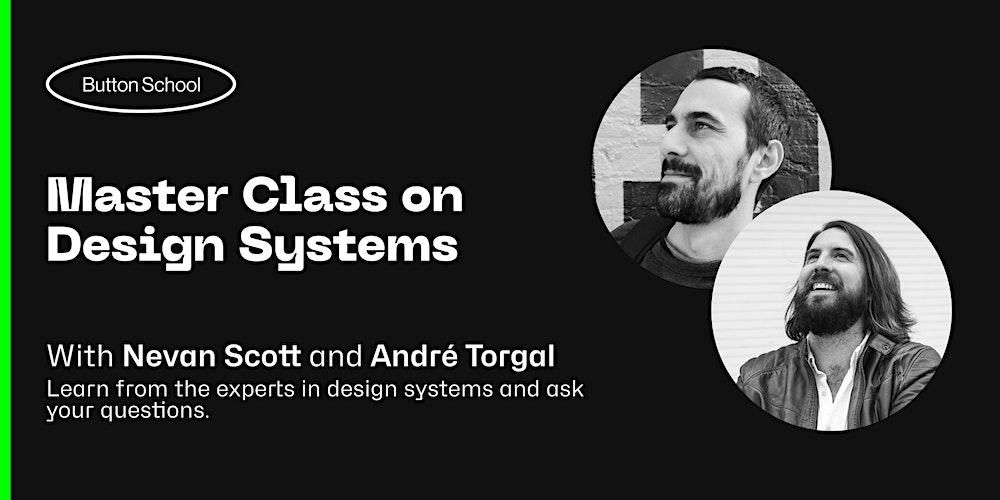Talking about design systems with strangers
Last week I had the privilege of sharing a virtual stage with my good friend Nevan Scott to talk about design systems and Button School’s new Design Systems Short Course. Great turn up! :star-struck: And great to see so many people excited about this topic, asking interesting questions, sharing their experience, and eager to get busy designing and building. :open_hands:

Look! 🦉 🦉 This is the best design school in the neighborhood. 🦉 🦉 Possibly the best one in town. So even if you are not currently thinking about studying, consider following them: Button School
Thank you for coming
About 100 people signed up for the event and more than 50% turned up! This exceeded the best expectations in both the numbers and actual engagement, so thank you all for showing up!
Thank you! To the writers, researchers, engineers, designers, all sorts of professionals and students that picked up the signal on the networks, and connected from different parts of the world. 🌏
Thank you to the familiar faces - it was great to see you! 😍 - and thank you!! to the strangers that stayed with us a good bit beyond the scheduled hour, asking the most interesting and relevant questions, and sharing their experience with us as well.
What did we talk about?
We dug into our memories asking when did you first hear the words “design system” for the first time?. And we went on a bit too long, a bit too nostalgic, about the evolution in technologies, business practices, innovations in the craft, what brought us here, what … 😴
It got really interesting after the intro.
Feedback from a friend. ☝️
Everyone has a design system
All organisations that do design already have a system, even if they don’t call it by that name. And everyone that is making design decisions - whether contributing to the core or applying it in normal - they are as well a part of the system.
Also, design systems are always evolving even when they’re not intentionally designed by the organisation. And we argue that from the explicit design of the culture, processes and tools, organisations can unlock tremendous value and potential. Especially if they apply design and systems thinking, together with lean and agile evolutionary principles.
Meanwhile, I wrote a bit more about what is a design system?. A question that has thousands of answers on the web, but you can now dig into without leaving my website. 😇 If you are into systems things you might want to take a look.
What are the benefits of systematising design?
Designing and building complex digital products usually involve making many repetitive decisions around small building blocks.
But it doesn’t have to be like this.
For every decision that is standardised, documented, and reused by several people, you get faster and more consistent results, and we can all move on to focus on solving more interesting and valuable problems than should it be 12px or 16px spacing between these two buttons?.
And depending on how you go about building your system, you can unlock many more benefits: stronger brand equity, better user experience, more engagement, higher conversion rates, less churn, more customer loyalty.
I meanwhile wrote a post about the impact of design systems, but here’s the quick summary:
- 📉 lower costs, less waste
- 📈 faster, more, further, better results
- equals 💰 and 😺
Challenges and strategies
We talked about some of the most common challenges to rolling out a successful design system:
- knowing where to start, what to prioritise first
- measuring the impact and the progress
- increasing adoption
- balancing contributions with governance
- keeping documentation up to date
- migrating those parts of the product that usually receive less love
And, eventually, we shared some useful advice and hopefully inspired some people to continue improving their craft.
I know I left inspired for sure. Grateful for the engagement, the questions, and the insights generated by the great conversations. Inspired to go and learn more, to write more, to better organise my thoughts, and to explain things more clearly.
I will probably be writing more about design systems soon. Here are some ideas, mostly inspired by the conversations we had at the event:
- Treating design systems like an internal product: advantages and limitations.
- Lean approach: start where you are, take one baby step at a time.
- Train the essential muscles: pattern recognition, abstraction, feedback.
- Less is more: prefer quality over quantity.
- Design principles are essential to drive cohesion and consistency.
- Professional documentation goes a long way.
- Applying user research to improve design systems.
Meanwhile, there’s already some content about design systems on this website. 💪 It’s a start.
The time is now
When the wall street is telling their friends to just do it, it’s time to get with the program.
By 2025, over half of all new digital products globally will be traceable to a platform-based or open-source design system. Insights from Gartner’s design system effectiveness report
It’s likely that in the next couple of years no code tools and design systems as a platform become widely available, helping smaller companies raise their game without the need to build and maintaining their own in-house systems.
In other words, it’s likely that design systems become more of a commodity, and a less challenging topic for many organisations. And in other news it’s also likely that artificial intelligence is going to change everything - literally everything 👽 - making it harder to predict what our role will be in that brave new world.
Recommended reading
Previous post Playing with fire: AI image generators
Next post Shokz OpenRun: game changing bone conductive headphones